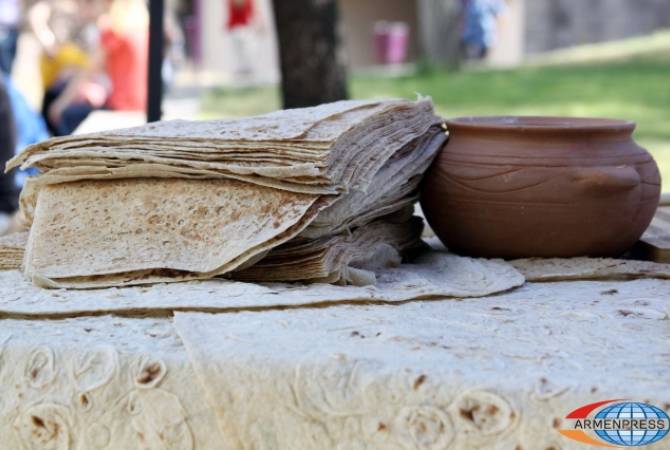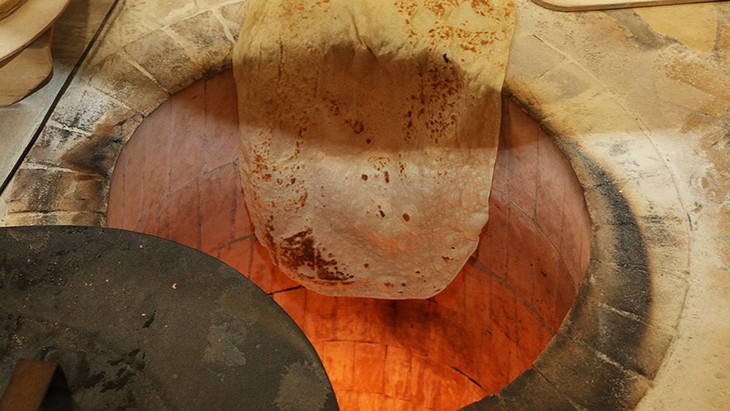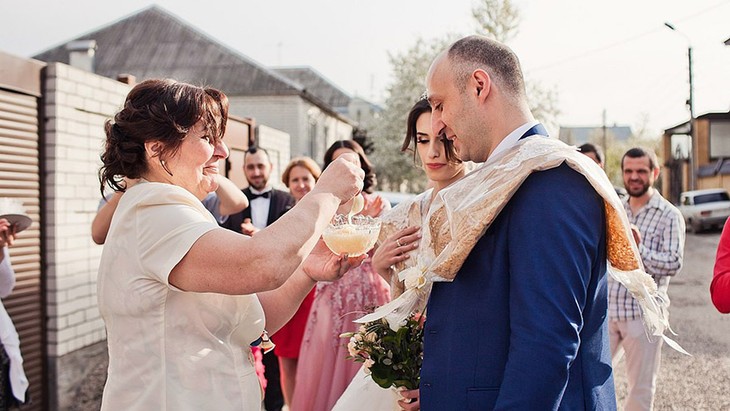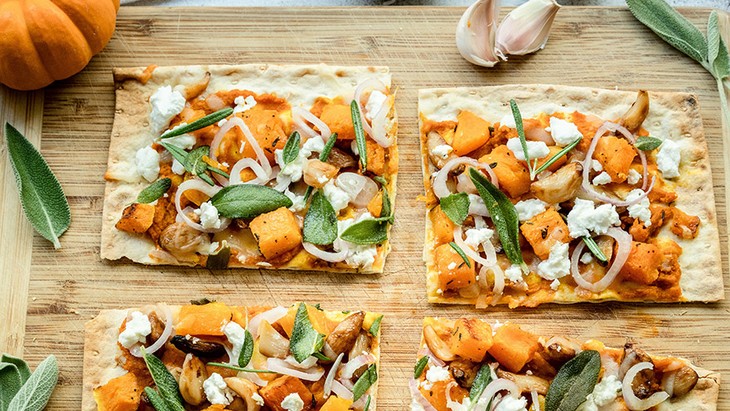National Post, Canada
Jan 13 2020
Cook this: Lavash — griddled flatbread — from a reflection on Armenian food of the same name
'We're hoping to instil a slow-burning, long-lasting kind of lavash love'

A staple in Armenia, lavash is eaten throughout the South Caucasus and Western Asia.John Lee
by Laura Brehaut
Our cookbook of the week is Lavash: The bread that launched 1,000 meals, plus salads, stews, and other recipes from Armenia by food writer Kate Leahy, photojournalist John Lee and chef Ara Zada. Over the next three days, we’ll feature more recipes from the book and an interview with its authors.
Deeply symbolic of the Armenian table, “blistered, chewy, pliable” lavash is popular throughout the South Caucasus and Western Asia. As authors Kate Leahy, John Lee and Ara Zada learned in their travels around Armenia, while there are many differences between how Eastern and Western Armenians cook, the flatbread — traditionally cooked in a tonir (underground clay oven) by small groups of women — is a constant.
“One of the things that was consistent on both sides was really making lavash,” says Leahy. “Lavash was being made in villages in the Ottoman Empire, in Anatolia, before the genocide and it was as well in Eastern Armenia. And even though the Soviets would have loved for them to make a fluffier more Russian-style bread, no one ever stopped making lavash.” (Armenia was part of the Soviet Union from the 1920s until its dissolution in 1991.)
The authors set out to write a recipe that would produce bread with similarly “satisfying results” — minus the tonir and well-practiced team of bakers — in a home kitchen. The result of their research and experimentation, three options for griddling lavash follow: an overturned wok, cast-iron griddle and grill. Whichever method you choose, the authors write, remember that the first-pancake rule applies. That is, consider the first lavash a treat for the cook as you tweak the temperature to get it right.

Lavash: The bread that launched 1,000 meals, plus salads, stews, and other recipes from Armenia by Kate Leahy, John Lee and Ara Zada. Chronicle Books
LAVASH
Old dough:
1/2 cup (70 g) all-purpose flour
1/4 cup plus a scant 1 tbsp (70 mL) lukewarm water
1/4 tsp instant yeast
Dough:
1 cup (240 mL) lukewarm water
1 tbsp sunflower oil or other neutral oil
2 tsp kosher salt
3 cups plus 2 tbsp (440 g) all-purpose flour, plus more for dusting
Step 1
To make the old dough, using your hands or a rubber spatula, squish together the flour, water and yeast in a bowl until it forms a thick paste. Scrape the paste into a small, lightly oiled container, cover and let it sit out for 1 1/2 to 2 hours, or refrigerate overnight and bring to room temperature for at least 2 hours before using. When ready, the ball will have doubled in volume.
Step 2
To make the dough, in the bowl of a stand mixer, combine the old dough, water, oil and salt. Squish the old dough with your hands to break it up in the water; it doesn’t have to be perfectly mixed in.
Step 3
Fit the stand mixer with the paddle attachment and add a third of the flour. Mix on low speed until the dough looks like pancake batter. Add the remaining flour and mix on low speed until incorporated. Remove the paddle attachment, pulling off any dough stuck to it. If there is flour at the base of the bowl, use your hands to press the dough into the flour. Cover the bowl with a kitchen towel and let the dough sit for 20 minutes to allow the flour to hydrate.
(To make by hand, combine the old dough, water, oil and salt in a large bowl and mix together, squishing the old dough into the water with your hands. Stir in the flour gradually with your fingers until a crumbly dough forms, then knead it a few times in the bowl by folding the dough over itself and pressing it down into the bowl. Cover the bowl with a kitchen towel and let the dough rest for 20 minutes.)
Step 4
Remove the towel and attach the dough hook to the stand mixer. Mix the dough on medium speed until the dough releases from the sides of the bowl without sticking and feels smooth to the touch, about 4 minutes. Turn the mixer off and reposition the dough to the centre of the bowl if it seems to get stuck on one side of the bowl.
(To knead by hand, dust the counter lightly with flour and place the dough on top. Begin kneading by stretching and folding the dough over itself until it is smooth to the touch, 5 to 7 minutes.)
Step 5
Lightly oil an 8 cup (2 L) glass Pyrex or a large glass bowl and place the dough inside. Cover the bowl with a lid, a plate, or plastic wrap and let it rest for 3 hours or until doubled in volume. Or refrigerate overnight and let the dough come to room temperature for at least 2 hours before portioning.
Step 6
To portion and shape the dough, dust the counter lightly with flour and place the dough on top. Using a bench scraper or knife, cut the dough into eight pieces about 3.5 oz (100 g) each.
Step 7
To shape the dough, cup the palm of your hand over one portion at a time and move your hand in a circle. The friction from the counter will help form the dough into a ball. If there is too much flour on the surface and the dough is sliding around, give the counter a spritz of water and try again. Lightly oil a rimmed tray and place the dough on the tray, ensuring that the portions are not touching. Cover with a kitchen towel or plastic wrap lightly coated with oil. Leave out for 1 to 1 1/2 hours, or until puffy, or refrigerate for up to 3 days. If you refrigerate the dough, use plastic wrap to cover it and expect it to take an hour or two to return to room temperature before it is ready to be rolled out.
Step 8
Dust the counter lightly with flour. Pat a portion of dough into an oval with your fingertips. Using a rolling pin and moving back and forth, roll the dough as thinly as possible into an oval about 13 by 9 in (33 by 23 cm). If the dough resists stretching, let it relax and start working on another portion before returning to it. You can also gently stretch the dough with your hands to correct the shape. It doesn’t have to look perfect. To griddle the lavash, follow the instructions that follow.
Note: To turn leftover lavash into crackers, tear or cut the lavash into chip-size pieces and place them in a single layer on a sheet pan. Brush the pieces with a little oil, sprinkle them with salt and then toast them at 400°F (200°C) until golden brown and crispy, about 6 minutes.
Makes: eight 13 by 9 in (33 by 23 cm) sheets

To griddle lavash, choose one of the following options:
OVERTURNED WOK
Step 1
Place a carbon-steel wok upside down over a burner. Have a pair of tongs handy.
Step 2
Heat the wok over high heat for 1 minute or until a sprinkle of water instantly evaporates.
Step 3
Drape the dough over the wok. Cook for 1 minute or until you can lift it easily from the wok with tongs and it has puffed slightly and blistered. Turn the dough over to briefly cook the other side, no more than 30 seconds. For extra browning, flip it over for another 30 seconds.
Step 4
Transfer the lavash to a half-sheet pan and cover with a dry kitchen towel while you cook the rest of the dough. In between batches, turn off the burner. The wok heats up quickly and it will get too hot if the burner is left on.
CAST-IRON GRIDDLE
Step 1
Place a 20 in (50 cm) cast-iron griddle over two burners. Heat the griddle over medium-high heat for a few minutes or until a sprinkle of water instantly evaporates.
Step 2
Drape the dough over the griddle. Cook for 1 minute or until you can lift the dough easily with tongs and it has puffed slightly and blistered. Turn the dough over to briefly cook the other side, no more than 30 seconds. For extra browning, flip it over for 30 more seconds.
Step 3
Transfer the lavash to a half-sheet pan and cover with a dry kitchen towel while you cook the rest of the dough. In between batches, keep the griddle turned on, but monitor its heat so it doesn’t get too hot.
GRILL
Step 1
Have tongs, a pastry brush, a small bowl of vegetable oil and 2 half-sheet pans ready. Coat one of the pans lightly with oil.
Step 2
Heat a gas grill over medium-high heat or prepare a charcoal grill for direct-heat cooking. Ensure that the grill grates are clean. The grill should be hot enough that you can only hold your hand over the grates for 3 to 5 seconds. Place a sheet of dough onto the oiled pan and brush oil on top. Drape the oiled dough over the grill. Cover the grill and cook for 25 seconds. Uncover the grill. Using tongs, turn the lavash over and let it cook for another 25 seconds, uncovered, or until evenly blistered and puffed in parts.
Step 3
Transfer to the clean half-sheet pan and cover with a dry kitchen towel while you cook the rest of the dough.
Eat the lavash soon after making it or store it in plastic bags to keep the bread pliable. It’s okay if it dries out and turns brittle; just rehydrate it by misting the lavash with water and covering it with a towel to let it soften. Soon after, it should be pliable enough to roll up without cracking. If it’s still cracking, mist with more water.
Excerpted from Lavash: The bread that launched 1,000 meals, plus salads, stews, and other recipes from Armenia by Kate Leahy, John Lee and Ara Zada (Chronicle Books). Copyright © 2019. Used with permission from the publisher.
 11:15, 16 January, 2020
11:15, 16 January, 2020
























